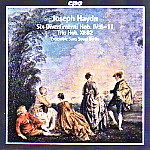This music is light and delicious. Haydn wrote these six divertimentos for the English domestic market, and scored them for flute, violin, and cello. Most of the music was arranged from chamber and orchestra scores. A number of movements came from the opera Il mondo della luna, but formally Haydn is as inventive as ever. All six works have three movements, but their order changes constantly: some begin with Adagios; others have a fast-slow-fast shape. There are concluding minuets, and there’s even a central scherzo.
The performances here are as lively as the music, if perhaps not quite so polished. All of the players are members of the Huntgeburth family, and flutist Christoph takes a prominent solo role. He plays marvelously, especially for a period instrument. His string-toting family members have that dry, inexpressive “period” sound that no self-respecting 18th-century player would tolerate for two seconds, but their intonation at least is very good, and as accompanists they do a fine job. They are also somewhat backwardly balanced, not a bad thing, as it turns out. All in all, this isn’t perfect, but the music deserves your attention, and the performances make it a very easy listen.
































